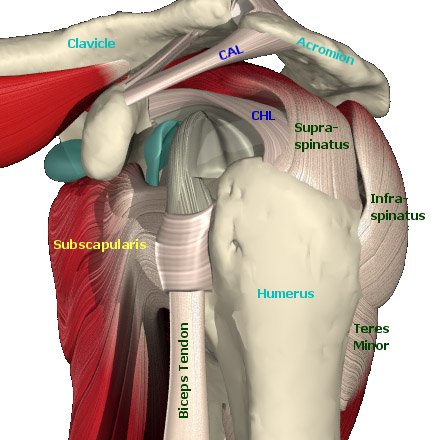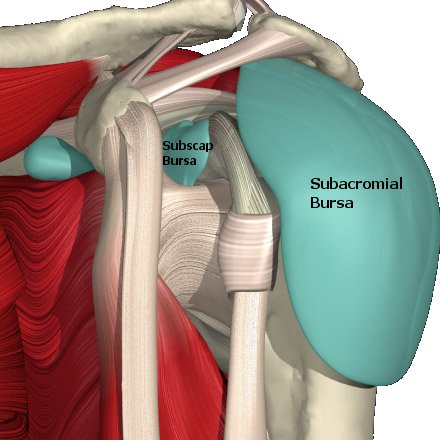The shoulder is one of the most sophisticated and complicated joints of the body:
- It has the greatest range of motion of any joint in the body allowing complete global movement allowing you to position the hand anywhere in space.
- The coordinated activity of numerous muscles working together in set patterns is required to produce this motion
- It is made up of FOUR joints and FIVE linked bone groups which are related and work together.
- To allow so much movement the joints need to be 'free' to move, therefore the shoulder should be unstable; However a series of complex ligaments and muscle keep it in joint.
This page will hopefully explain some of the terminology you might hear and relate this to disorders of the shoulder complex. Understanding how the different layers of the shoulder are built and connected can help you understand how the shoulder works. The deepest layer includes the bones and the joints of the shoulder. The next layer is made up of the ligaments of the joint capsule. The tendons and the muscles come next.
Bones and JointsThe bones of the shoulder are the humerus (the upper arm bone), the scapula (the shoulder blade), and theclavicle (the collar bone). The roof of the shoulder is formed by a part of the scapula called the acromion.
There are four joints making up the 'shoulder joint':
- The shoulder joint itself (also known as theGlenohumeral joint, as it is between the glenoid and the humerus)
- The acromioclavicular (AC) joint (where the clavicle meets the acromion of the scapula)
- The sternoclavicular (SC) joint (where the clavicle meets the chest bone [sternum])
- The scapulothoracic joint (where the scapula meets with the ribs at the back of the chest)
Ligaments and TendonsThere are several important ligaments in the shoulder. Ligaments are soft tissue structures that connect bones to bones. A joint capsule is a watertight sac that surrounds a joint. In the shoulder, the joint capsule is formed by a group of ligaments that connect the humerus to the glenoid. These ligaments are the main source of stability for the shoulder. They help hold the shoulder in place and keep it from dislocating. These are the glenohumeral ligaments (GHL)
Another ligament links the coracoid to the acromion - coracoacromial ligament (CAL). This ligament can thicken and cause Impingement Syndrome
Ligaments attach the clavicle to the acromion in the AC joint.
Two ligaments connect the clavicle to the scapula by attaching to the coracoid process, a bony ridge on the scapula - coracoclavicular ligaments (CCL)
 |
| Ligaments of the Shoulder Complex:CCL - coracoclavicular ligaments CAL - coracoacromial ligaments SGHL - Superior GlenoHumeral Ligament MGHL - Muperior GlenoHumeral Ligament IGHL - Inferior GlenoHumeral Ligament |
The rotator cuff tendons are a group of four tendons that connect the deepest layer of muscles to the humerus. They are the tendons of the rotator cuff muscles (below)
 |
Tendons of the shoulder:From front to back:
|
There are three important groups of muscles around the shoulder:
1. Surface muscles (Extrinsic):
- The large deltoid muscle forms the outer layer of muscle. This is the largest, strongest muscle of the shoulder. The deltoid muscle takes over lifting the arm once the arm is away from the side.
- Pectoralis Major provides movement and support in the front of the shoulder
- The rotator cuff tendons attach to the deep rotator cuff muscles. These 4 muscles are involved in raising the arm from the side and rotating the shoulder in the many directions. The rotator cuff mechanism also helps keep the shoulder joint stable by holding the humeral head in the glenoid socket. These muscles are: subscapularis, supraspinatus, infraspinatus and teres minor.
- These muscles are at the back of the shoulder that stabilise and move the scapula on the trunk of the body. This group includes the trapezius, rhomboids, levator scapulae, and the serratus anterior muscles; and are concerned with stabilisation and rotation of the scapula.
 |
| Surface muscles of the shoulder (from the front) |
All of the nerves that travel down the arm pass through the axilla (the armpit) just under the shoulder joint and are known as the Brachial Plexus before dividing into the individual nerves. These nerves carry the signals from the brain to the muscles that move the arm. The nerves carry signals back to the brain about sensations such as touch, pain, and temperature.
Two very important nerves around the shoulder are theaxillary nerve, which supplies the Deltoid muscle and themusculocutaneous nerve, which supplies the Biceps muscle. They can be damaged with trauma or surgery around the shoulder joint.
Blood VesselsTraveling along with the nerves are the large blood vessels that supply the arm with blood. The large axillary arterytravels through the axilla as well. If you place your hand in the armpit, you may be able to feel the pulsing of this large artery.
BursaSandwiched between the rotator cuff muscles and the outer layer of large bulky muscles is a structure known as abursa. Bursae are everywhere in the body. They are found wherever two body parts move against one another and there is no joint to reduce the friction. A bursa is simply a sac between two moving surfaces that contains a small amount of lubricating fluid.
Think of a bursa like this: If you press your hands together and slide them against one another, you produce some friction. In fact, when your hands are cold you may rub them together briskly to create heat from the friction. Now imagine that you hold in your hands a small plastic sack that contains a few drops of salad oil. This sack would let your hands glide freely against each other without a great deal of friction.
 |
| Bursa of the shoulder |


Комментариев нет:
Отправить комментарий